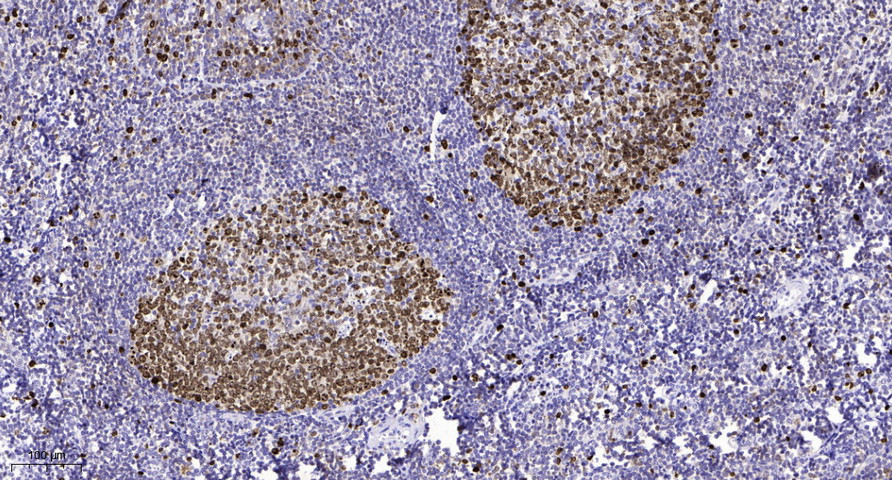WWOX Polyclonal Antibody
- Catalog No.:YT4909
- Applications:WB;IHC;IF;ELISA
- Reactivity:Human;Mouse
- Target:
- WWOX
- Gene Name:
- WWOX
- Protein Name:
- WW domain-containing oxidoreductase
- Human Gene Id:
- 51741
- Human Swiss Prot No:
- Q9NZC7
- Mouse Gene Id:
- 80707
- Mouse Swiss Prot No:
- Q91WL8
- Immunogen:
- The antiserum was produced against synthesized peptide derived from human WWOX. AA range:1-50
- Specificity:
- WWOX Polyclonal Antibody detects endogenous levels of WWOX protein.
- Formulation:
- Liquid in PBS containing 50% glycerol, 0.5% BSA and 0.02% sodium azide.
- Source:
- Polyclonal, Rabbit,IgG
- Dilution:
- WB 1:500 - 1:2000. IHC 1:100 - 1:300. IF 1:200 - 1:1000. ELISA: 1:20000. Not yet tested in other applications.
- Purification:
- The antibody was affinity-purified from rabbit antiserum by affinity-chromatography using epitope-specific immunogen.
- Concentration:
- 1 mg/ml
- Storage Stability:
- -15°C to -25°C/1 year(Do not lower than -25°C)
- Other Name:
- WWOX;FOR;WOX1;WW domain-containing oxidoreductase;Fragile site FRA16D oxidoreductase
- Observed Band(KD):
- 47kD
- Background:
- WWOX (WW domain containing oxidoreductase) encodes a member of the short-chain dehydrogenases/reductases (SDR) protein family. WWOX spans the FRA16D common chromosomal fragile site and appears to function as a tumor suppressor gene. Expression of the encoded protein is able to induce apoptosis, while defects in this gene are associated with multiple types of cancer. Disruption of WWOX is also associated with autosomal recessive spinocerebellar ataxia 12. Disruption of a similar gene in mouse results in impaired steroidogenesis, additionally suggesting a metabolic function for the protein. Alternative splicing results in multiple transcript variants.
- Function:
- skeletal system development, ossification, osteoblast differentiation, induction of apoptosis, steroid metabolic process, negative regulation of signal transduction, negative regulation of cell communication, regulation of cell death,positive regulation of cell death, induction of programmed cell death, regulation of Wnt receptor signaling pathway,negative regulation of Wnt receptor signaling pathway, regulation of apoptosis, positive regulation of apoptosis,regulation of programmed cell death, positive regulation of programmed cell death, skeletal system morphogenesis,oxidation reduction, bone development,
- Subcellular Location:
- Cytoplasm . Nucleus . Mitochondrion . Golgi apparatus . Partially localizes to the mitochondria (PubMed:14695174). Translocates to the nucleus upon genotoxic stress or TNF stimulation (By similarity). Translocates to the nucleus in response to TGFB1 (PubMed:19366691). Isoform 5 and isoform 6 may localize in the nucleus. .
- Expression:
- Widely expressed. Strongly expressed in testis, prostate, and ovary. Overexpressed in cancer cell lines. Isoform 5 and isoform 6 may only be expressed in tumor cell lines.
EBV-LMP1 regulating AKT/mTOR signaling pathway and WWOX in nasopharyngeal carcinoma. International Journal of Clinical and Experimental Pathology Int J Clin Exp Patho. 2017; 10(8): 8619–8625 WB Human CNE1-LMP1 cell,CNE1
- June 19-2018
- WESTERN IMMUNOBLOTTING PROTOCOL
- June 19-2018
- IMMUNOHISTOCHEMISTRY-PARAFFIN PROTOCOL
- June 19-2018
- IMMUNOFLUORESCENCE PROTOCOL
- September 08-2020
- FLOW-CYTOMEYRT-PROTOCOL
- May 20-2022
- Cell-Based ELISA│解您多样本WB检测之困扰
- July 13-2018
- CELL-BASED-ELISA-PROTOCOL-FOR-ACETYL-PROTEIN
- July 13-2018
- CELL-BASED-ELISA-PROTOCOL-FOR-PHOSPHO-PROTEIN
- July 13-2018
- Antibody-FAQs
- Products Images

- Western blot analysis of lysates from HepG2 cells, using WWOX Antibody. The lane on the right is blocked with the synthesized peptide.

- Immunohistochemical analysis of paraffin-embedded human tonsil. 1, Antibody was diluted at 1:200(4° overnight). 2, Tris-EDTA,pH9.0 was used for antigen retrieval. 3,Secondary antibody was diluted at 1:200(room temperature, 45min).


